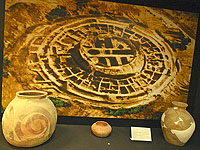 |
|
Uzbekistan - Decorative-applied Arts |
||||
|
Handicraft developed in Uzbekistan from century to century, leaving unique products of the unknown foremen with rich arts, imaginations and perfection in Uzbek heritage. Due to the changes of social and economic conditions, handicrafts gradually became the second after industrial productions on an extent of 20th century. Nowadays, in Uzbekistan enormous attention is rendered towards national foremen in the field. The careful attitude towards the traditional cultural values became one of the main ranks of state policy. The revival of handicraft traditions was part of a logical progress, derived from the aspiration to preserve the national culture. In the last years, the government adopted several laws related to the revival of national handicrafts and traditions. A number of the national artists were elected as the academicians of the Academy of Applied Arts of Uzbekistan. A title "0'zbekiston Respublikasi khalq ustasi" legislatively authorized with Faskhitdin Dadamukhammedov becoming the first handicraft to be called so. At the research and production center "Mitsavvir" (artist) the association of the national artists "Khunarmand" (skillful craftsman) was formed, the divisions of which operates nationwide. The main aim of these organizations is restoration of forgotten section of art history, assistance to the handicraftsmen in manufacturing and sales of production. Moreover, the handicraftsmen were assisted by several international funds and organizations, which became possible due to the open state policy. The organization of various international festivals and fairs became traditional under aegis of the state organizations. These fairs stimulate growth of craft manufacture, promote a rank by experience, and define the market. In 1995, in the first large fair was organized under the supervision of the UN. This initiative was also supported by several other international organizations interested in the development of tourism and economy of the newly independent states. On an extent of a number of years the UN Project "Cultural-educational tourism and handicraft development" and Project "Aid to the handicraftsmen" of the Counterpart Consortium, operated in Uzbekistan, which rendered significant support to the national artists. One of the recent actions by the UN Project as an aid to the handicraftsmen was the sale-exhibition, namely "Craft products of Uzbekistan" held in November 1998. Ceramics.Pottery was one of the most developed manufactures of the Central Asia for several years. Spray and dry ceramics of the leading centers had local peculiarities that have been reflected in the original forms of final products. Number of local pottery centers are preserved to present days, such as Rishton, Ghijduvon, Khiva, Samarkand, Gurumsaray, Shakhrisabz, Urgut, Khorezm and Tashkent. In the last years, historic centers of manufacture are revived, assortment of products extended with their quality improving significantly- Feeling support on the part of the state, now foremen are increasing production to extend competitiveness of their products. They strive to preserve local features of production, and are restoring the forgotten forms and drawings. At the same time, new forms of handicraft motives are emerging. The artists of the Samarkand school revive traditions of an ornament of vessels by elements of animals and birds. In Rishton elder artists and representatives of young generation are masters of both - technical and handicraft motives (kuzagar and nakkosh). Distinctive feature of Rishton ceramics is a dichromatic color, and syrup paint, which is usually taken from the ashes of plants. At the moment, the artists work with ready alkaline products. Foremen in the area mainly produce ceramics with paintings of various flora, as well as knife, birds, fishes, and architectural motives. Tradition of manufacturing the duck-style vessel for mussallas ('local wine') is revived. |


